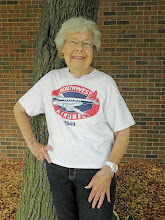1957 Air Fares
At a talk I gave yesterday at the Minnetonka Community Center, one participant asked about air fares in the 1950s. Most particularly, the difference in fare between first class and coach.
Remember now, there were no "class" divisions on aircraft back then. There were only two classes, first class and coach, and the whole airplane was one class or the other. There was no "business class" or "economy class," either.
I neglected to bring my March, 1957 Northwest Airlines timetable and rate chart with me yesterday, and promised to publish some fares today on my blog for those interested.
1957 Minneapolis-St. Paul to New York, round trip First Class Fare: $117.10
1957 Minneapolis-St. Paul to New York, round trip Coach Fare: $95.40
Yesterday I guessed the difference between first class and coach to New York fifty years ago might be around $25.00. Turns out it was $21.70. Not too shabby for an old girl, right? But I must confess, I was thinking in terms of one-way, not round-trip.
The following were International fares to Tokyo, Japan from MSP:
1957 First Class, round trip: $1,356.70. Tourist Class (overseas coach) round trip: $1,022.20
It's very hard to compare the fares of fifty years ago to today's fares for many reasons - not the least of which is the fact that most U.S. airlines were subsidized by the government back then, before deregulation took hold in the 1980's. Also, the plethora of "classes" available now makes any kind of comparison dicey. But here's an unscientific attempt. The following fares were quoted today on NWA.com:
2008 round trip First Class fare to New York from MSP: $1,151.00
2008 round trip Coach fare to New York from MSP: $301.00
And International round-trip fares to Tokyo, Japan from Minneapolis-St. Paul:
2008 First Class: $2,169.34 Coach: $1,545.34
All of the 2008 fares include taxes and fees but exclude luggage fees.
I will leave analysis up to you, dear reader. I know all sorts of things enter in here - like present value of the dollar, etc. And how does one quantify the difference in dollars between government subsidy and free market? Even experts like Alan Greenspan seem to get it wrong from time to time, so I'm not touching this one. It does seem, however, that airlines in the 1950s were kinder and gentler on the pocketbook as well as the experience.






0 Comments:
Post a Comment
Subscribe to Post Comments [Atom]
<< Home